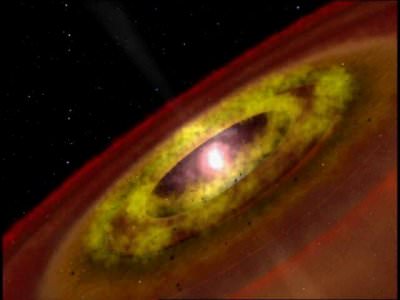[/caption]
When a star is still in the earliest stages of formation, it doesn’t have enough temperature in its core to ignite fusion of hydrogen and helium. Instead, the star shines with just the gravitational energy of its continue collapse. Astronomers call this pre-star a T Tauri star. This early stage lasts about 100 million years before nuclear fusion kicks in and it becomes a true star.
As you might know, stars start out as vast clouds of cold molecular hydrogen. Some event, like a nearby supernova, causes the cloud to collapse. As it collapses, the cloud fragments into separate pieces, each of which will eventually become a star. The first stage in a star’s life is as a protostar. This is where fresh material is still falling into the center of the collapsing cloud. After about 100,000 years or so, everything is collected, and the T Tauri star gets going.
T Tauri stars actually look quite similar to main sequence stars. Their surface temperatures are about the same as a star of a similar mass, but they’re more luminous because they have a larger diameter. But T Tauri stars get all their energy from the gravitational collapse of the material. They’re violent babies. There’s evidence that T Tauri stars are covered with active sunspots, and they produce extremely powerful stellar winds. Some of the brightness we see from here on Earth is the T Tauri star’s powerful stellar winds heating up a protoplanetary disk surrounding them.
Over 100 million years, these stars slowly collapse until the temperature and pressure at their core is sufficient to ignite stellar fusion. At this point, the star is converting hydrogen into helium at it’s core, and has become a main sequence star.
A star like our Sun will remain a main sequence star for about 12 billion years, as long as the fuel lasts in its core.
We have written many articles about stars here on Universe Today. Here’s an article about about two telescopes acting together to image a T Tauri star, and here’s an article about a T Tauri binary ejected from its system.
Want more information on stars? Here’s Hubblesite’s News Releases about Stars, and more information from NASA’s imagine the Universe.
We have recorded several episodes of Astronomy Cast about stars. Here are two that you might find helpful: Episode 12: Where Do Baby Stars Come From, and Episode 13: Where Do Stars Go When they Die?
Reference:
Wikipedia

